jetcityimage/iStock Editorial via Getty Images
I’m assigning Ford Motor Company (NYSE:F) a positive risk/reward rating based on its discounted valuation, long-term technical support, leading market position in trucks, its competitive positioning in SUVs, and its vision for autonomous vehicles.
Risk/Reward Rating: Positive
To set the stage for the Ford investment case, I will begin by contrasting Ford’s approach to autonomous vehicles with that of Tesla’s (NASDAQ:TSLA). Please keep in mind that Tesla is currently valued at over 14x Ford ($1 trillion vs. $72 billion). This comparison is important as many prominent analysts assign incredible upside potential to Tesla based on autonomous ride-hail (otherwise known as robotaxis) revenue.
For example, Ark Invest released a Tesla valuation model in March of 2021 which projected up to $327 billion of revenue for Tesla in 2025 from robotaxis alone, under a bullish scenario. The valuation potential for this level of high-margin revenue would be enormous. Ark’s bullish valuation scenario for Tesla is $4 trillion by 2025, with robotaxis accounting for 47% of Tesla’s total revenue.
As a result, the Tesla robotaxi business alone would be valued in the $2 trillion range under Ark’s bullish scenario. For comparison, Ford produced $136 billion of total revenue in 2021 and is currently valued at $72 billion. Tesla produced $54 billion of revenue in 2021 and is valued at just over $1 trillion.
Tesla
In its Q4 2021 investor letter, Tesla announced that its FSD or Full Self Driving system was expanded to 60,000 people from just a couple of thousand in the prior quarter. These beta testers are Tesla owners rather than Tesla employees. They’re laypeople. In essence, Tesla’s approach to autonomous vehicle system development is to use its customers to train and develop its autonomous vehicle platform.
Tesla’s FSD beta customers are basically unpaid data collectors who train Tesla’s FSD systems as they travel. In fact, the beta testers are actually paying Tesla to be an extension of its research and development team in the field. This consumer-led autonomous vehicle strategy introduces a fundamental and pervasive quality control risk to the development of Tesla’s autonomous vehicle platform.
For example, the NTSB has opened an investigation into Tesla crashes while the vehicles were on autopilot. There have been 11 crashes with parked emergency vehicles since 2018. The company responded that it’s safer to use autopilot compared to driving without their advanced cruise control technology.
The NTSB case also highlights the societal externalities resulting from Tesla’s approach to autonomous vehicle development. By definition, these unskilled, non-professional testers are turning the general public into unwitting Tesla test subjects. In essence, the company has shifted a substantial portion of its cost to develop autonomous vehicle systems onto its customers and more importantly the general public.
Argo AI
Ford has taken a distinctly different approach to autonomous vehicle development. Argo AI is a private company headquartered in Pittsburgh and represents one of Ford’s more advanced autonomous vehicle development programs. Ford and Volkswagen (PINK:OTCPK:VWAGY) each own 41% of Argo AI. Argo AI’s employees and Lyft (NASDAQ:LYFT) own the remaining 18% of the company. The following quotes are from an interview with Bryan Salesky, Argo AI’s CEO, “Meet The Self-Driving Brains Working With Volkswagen And Ford” published on The Verge written by Nilay Patel. These quotes best summarize and exemplify the differing approach taken by Ford compared to Tesla.
The customer is not just the rider in the car, the customer is actually the bike that’s riding next to us, the pedestrian that’s crossing in front of the vehicle.”
Argo AI is different than Tesla in a crucial way. The focus is on the public good as the customer rather than just the desires of the auto manufacturer and its customers. This is the only vision that can win in autonomous vehicles as they affect the entire population. This is reinforced in the following quote from Argo AI’s CEO:
I think it’s easy to deliver a solution that doesn’t quite meet what people need… I look at it through a customer’s eyes. Is this the right thing to do? Is this meeting the promise that we made and the promises embedded in our core values? That’s why they’re on our website. Safety is number one.”
Finally, in speaking about the coming Argo AI commercial rollout with Lyft in major metropolitan areas, Salesky explains that safety is imperative: “They will have safety drivers in them… we have two people in the car at all times today…” Salesky’s vision for the evolution of autonomous driving is realistic as can be seen below:
I think that the dream was always suspect if the dream was, “We’re gonna deploy millions of cars and go from literally zero self-driving cars on the street, to millions in a couple of years.” I mean, change doesn’t happen that quickly.”
Elon Musk famously stated that Tesla would have 1 million robotaxis on the road by 2020. Clearly this was an unrealistic statement. Similar unrealistic projections were made in the past. Elon Musk tripled down on this line of thinking in discussing fully autonomous vehicle capabilities following the release of Tesla’s Q4 2021 results. In a recent Washington Post article, Musk was quoted as stating: “My personal guess is that we’ll achieve Full Self-Driving this year.”
While Tesla continues with its free-for-all robotaxi development program, Ford is taking a methodical and scientific approach to the development of autonomous vehicles. Importantly, Ford is internalizing the cost of development rather than shifting the cost onto its customers and the general public. It’s self evident that this is the responsible approach, and it’s highly probable that it will prove to be the most effective strategy when the dust settles. For the moment, however, Tesla remains the $1 trillion auto company.
Autonomous Vehicle Roadmap
The comparison to Tesla is important for the Ford investment case. The fantastic market value of Tesla includes a substantial amount for the presumed successful rollout of autonomous vehicle capabilities, or robotaxis. If competitors are taking a more realistic approach toward the likely evolution of the autonomous vehicle market over the coming 3-5 years, the value currently assigned to Tesla’s robotaxi capabilities provides a strong signal regarding the potential upside.
Ford’s vision for the evolution of the autonomous vehicle market appears to be more credible than Tesla’s. It begins at the local level, which is the domain of taxi services in addition to most other use cases such as car rental and delivery services. Using the Argo AI strategy as the template, Argo employees first train and program the autonomous driving platform in each city. They incorporate not only the rules of the local roads and the operating conditions, but also the behavioral patterns of the human drivers and general population at the street level.
Argo AI’s comprehensive and methodical development approach enables the creation of predictive capabilities. This leads to a more advanced form of autonomous vehicle AI underlying the transportation platform. The training of Argo AI’s platform by its skilled workforce rather than laypeople, while being more expensive in the short run, appears to be a strategic competitive advantage for the platform long term.
Roadmap: Miami
Argo AI’s strategy in Miami highlights the natural market progression embedded in Ford’s autonomous vehicle roadmap. In partnership with Lyft, and using Ford’s autonomous-enabled hybrid Escape model, Argo AI will have 30 to 40 cars on the road initially. The Ford Escape happens to be the most similar vehicle in respect to Tesla’s basic model design.
Argo AI’s employees will operate the Lyft service. This will enable Argo AI to further train the system on the local driving conditions. There’s an incredible opportunity to educate and acclimate the local population to Argo AI and Lyft’s autonomous vehicle capabilities and to demonstrate their safety.
Ford will have the opportunity to build its brand goodwill in both the autonomous vehicle market as well as the electric vehicle market. Additionally, this roadmap allows Ford to showcase its capabilities with Lyft, which is a natural fleet buyer for Ford’s autonomous vehicles.
Successful market development and market penetration with Lyft in major metropolitan areas is the perfect stage on which to demonstrate Ford’s go-to-market strategy and capabilities. Ford can easily leverage these demonstrations with a multitude of transportation industry fleet buyers across taxi, rental, and delivery services.
The bottom up, local market penetration strategy with existing taxi service providers (using apps) looks to be far superior compared to the individual consumer car buying model being deployed by Tesla. Additionally, companies like Lyft, Uber, and rental car companies are first and foremost brands. Passenger safety is their No. 1 priority from a brand protection perspective.
Taxi, rental service, and delivery providers will choose the autonomous transportation platform that provides the highest degree of safety. Given that most of these services are local, the platform with the greatest degree of safety will be the one with the greatest degree of localized intelligence or AI. Argo AI’s use of its skilled employees to locally program and train their platform is likely to be a key factor weighed by the taxi, rental, and delivery service providers when choosing a transportation platform.
I view the probability of Ford outperforming Tesla in the robotaxi, rental, and delivery markets to be rather high, all things considered. Tesla’s history of not delivering on its autonomous driving projections, its public failures on the safety front, its inferior long-term robotaxi market penetration strategy, and its lack of a skilled workforce for training and programing its systems locally are the primary factors supporting my conclusion.
As a result, I view a substantial portion of Tesla’s current market capitalization to be up for grabs. While the autonomous vehicle market is intensely competitive, Ford’s approach with Argo AI (in partnership with Volkswagen and Lyft) and its proprietary in-house intellectual property development look to be a winning strategy. The early integration with taxi services such as Lyft places Ford amongst the top contenders for the robotaxi prize.
I will not speculate here on the total potential of the robotaxi, rental, and delivery services market for Ford. In the case of robotaxis alone, the $327 billion revenue opportunity calculated by Ark Invest for Tesla’s robotaxi business in 2025 offers a directional glimpse into what many of today’s growth investors believe.
I have no doubt that the robotaxi opportunity is an exceptionally large number which dwarfs Ford’s current $72 billion valuation. When rental and delivery services are added, the total market opportunity for autonomous vehicles is indeed massive. Furthermore, Ford’s approach with Argo AI in building a transportation platform opens the door to incredibly large opportunities in ancillary services and subscriptions that are only bounded by one’s imagination. If Ford can execute on its autonomous vehicle roadmap and larger vision, there’s incredible upside potential.
Ford
When asked in the interview (quoted above) about the relationship between electric vehicles and hybrid vehicles and autonomous driving use cases, Argo AI’s Bryan Salesky had this to say:
What I was looking at was that hybrids still had a lot of advantages because you can keep the car on the road for extended periods of time earning revenue.”
This is a simple yet profound statement regarding the reality and likely trajectory of the vehicle mix demanded by the market over the medium to longer term. The disadvantage of electric-only vehicles for commercial activities is the battery limitation. The limitations include battery range, speed of charging, performance fluctuation across environmental conditions, insufficient infrastructure, and the life expectancy of the battery under commercial scale usage and charging frequency.
Charging speeds and battery technologies will certainly improve with time which will increase the all-electric value proposition in the commercial sector. That said, commercial electric-only vehicles are and will remain incredibly fragile when compared to hybrid vehicles that can switch between battery and internal combustion power to maximize asset utilization. Additionally, the existing fueling infrastructure for internal combustion engines is already in place and offers refueling redundancy when coupled with future charging infrastructure that will be more broadly deployed.
As a result, there’s a compelling case to be made that the marketplace is overestimating the speed at which all-electric vehicles will penetrate the commercial vehicle market. For similar reasons, the consumer market transition to electric-only vehicles is likely to be prolonged.
Ford is positioned quite well for this long and varied transportation transition. The transition will be driven (no pun intended) by use cases and market demand. In this respect, Ford is strategically well positioned compared to the current market cap leader, Tesla. Furthermore, Ford’s strategy is much more resilient when observing the incredible uncertainty and wide range of potential outcomes facing the transportation industry though 2025 and onward.
Business Mix: US Market
While electric sedans have been thrust into the spotlight by Tesla, the consumer market in the United States has steadily shifted away from sedans toward trucks and SUVs. Additionally, the traditional car or sedan market has a history of intense pricing competition as the utility value of cars compared to trucks and SUVs is limited. This reality restricts pricing power outside of the upscale and luxury segments of the sedan market.
The following table displays Ford’s product sales mix in the US market. The table and those that follow were compiled from Ford’s 2021 10-K and 2019 10-K filed with the SEC. Please note that Ford’s unit sales are to the wholesale market (dealers and fleet customers) while the retail sales data represents end-market consumer demand.
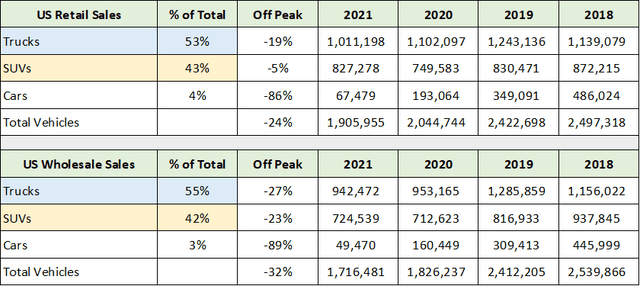
Source: Created by Brian Kapp, stoxdox
For all intents and purposes, Ford’s product sales are composed primarily of trucks and SUVs (highlighted above). This product mix looks to be a strategic decision on Ford’s part to avoid the hyper-competitive and elevated price sensitivity nature of the traditional car or sedan market. It should be noted that there’s a fine line between what some call SUVs and sedans today. Nonetheless, a casual comparison of Ford’s SUVs to Tesla’s sedans reveals the differences. Interestingly, Ford’s Mustang Mach-E beat Tesla’s Model 3 as Consumer Reports’ top electric vehicle for 2022.
Ford is the long-term market share leader in US truck sales, with its F-series pickup trucks dominating the market. The entrenched leadership position in trucks is a clear competitive advantage for Ford. Trucks derive a substantial portion of their value from utility or work use cases rather than mere transportation from point A to point B. This work or utility value opens the door to market share moats and sustainable value creation in the truck market compared to sedans.
In addition to pickup trucks, Ford offers a complete lineup of heavier-duty commercial trucks. The delivery truck or van market in particular offers long-term growth potential in solving the final mile delivery challenge. This is especially true as autonomous vehicles gain market traction. Automation of local delivery will unlock incredible value creation opportunities not only for transportation providers, but for the economy in general. Similar to trucks, SUVs offer a competitive advantage over sedans in the robotaxi, rental, and smaller scale delivery use cases.
Geographic Mix
Ford provides product mix details for the US market only, however, the company has a broad global footprint. International markets offer an incredible growth opportunity for Ford and are likely to follow the US market in terms of market demand and the resulting product mix. While Ford has stumbled in the past in several international markets, the company’s focus on trucks and SUVs going forward will likely serve it well. The following table displays Ford’s geographic sales mix.
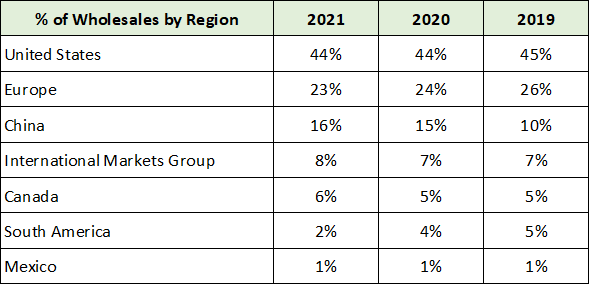
Source: Created by Brian Kapp, stoxdox
Notice that North American (US, Canada, and Mexico) sales account for 51% of Ford’s sales. Ford’s US and Canadian sales are mature near 44% and 6% of total sales, respectively. The underrepresentation of Mexico in the North American mix points toward substantial growth potential in that market. Ford has a strong market position with significant upside opportunity in the larger European and Chinese markets. The following table provides greater geographic detail.
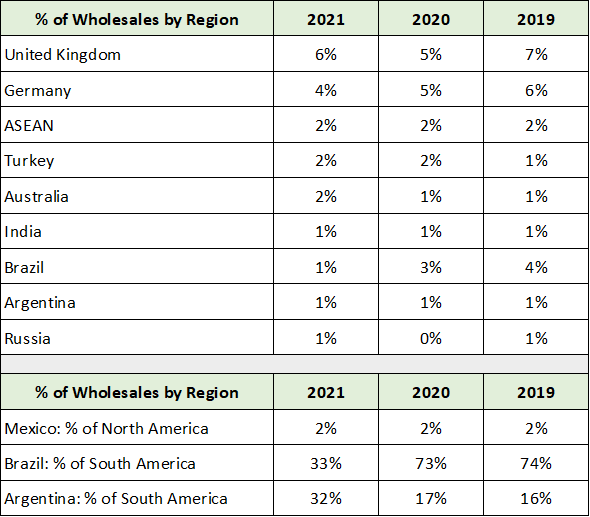
Source: Created by Brian Kapp, stoxdox
In the bottom section of the above table, I have highlighted Ford’s primary growth opportunities in the Americas. Mexico remains largely underpenetrated while Brazil and Argentina account for the majority of South American sales. Given that South America is a large market, at 2% of Ford’s total sales, there remains an extraordinary growth opportunity. The expansion opportunity throughout South America remains quite large. The upper portion of the table displays Ford’s strong position in the United Kingdom and Germany while highlighting the largely untapped potential in larger international markets.
Market Share
In order to quantify the international growth opportunity, the following table displays Ford’s market share by region. Ford’s market share in the US looks to be mature in the 12% to 13% range. The company’s US market share is an excellent upper limit on the potential market share globally.
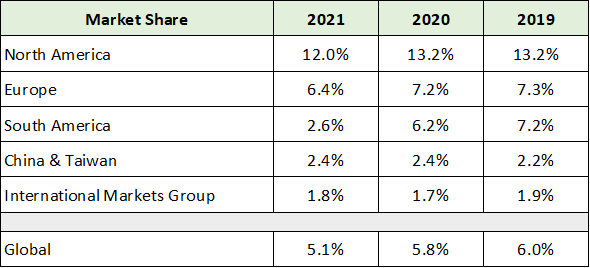
Source: Created by Brian Kapp, stoxdox
With 5% to 6% market share globally compared to the US market at 12% to 13%, Ford has substantial international expansion potential. While the company has stumbled in various regions in the past, the foothold in these markets will serve Ford well in the coming autonomous vehicle transition. In fact, as evidenced by the roadmap discussed above, Ford will be able to leverage the coming autonomous vehicle transition to grow its international market share.
Dealerships
While not a competitive advantage compared to traditional auto makers, Ford’s dealer network is a competitive advantage compared to Tesla and other automotive upstarts. This is the case because vehicles will likely continue to require local, professional service capabilities in order to maintain sufficient levels of customer satisfaction. The following table displays the trends underlying Ford’s dealer network.

Source: Created by Brian Kapp, stoxdox
The dealer network is being rationalized which is a common trend in the automotive industry. It’s provided here for reference and to emphasize the large distribution and service network Ford has built in relation to its upstart competitors. Full life cycle customer satisfaction will be a competitive differentiator for Ford against the likes of Tesla. Customer service is a key differentiator and a requirement for long term automotive success.
Financials
The past decade has been defined by stagnation for Ford and its traditional automotive competitors. Additionally, Ford and much of the industry have been in an automotive recession since 2018 as can be seen in the first table of this report (Business Mix: US Market). In fact, Ford’s US unit sales are down 32% since 2018. By anyone’s definition, the past three years have been a brutal recessionary environment for Ford.
This recessionary period was punctuated by the COVID pandemic and resulting production constraints due to supply chain disruptions and the subsequent dealer inventory liquidations. As a result, I will focus on the results in recent years as they offer an excellent baseline from which to grow Ford’s existing operations (excluding the large growth opportunities discussed above). The following table breaks down Ford’s profitability by segment since 2019.
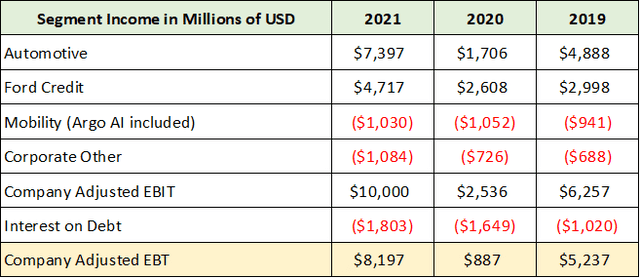
Source: Created by Brian Kapp, stoxdox
I have highlighted in yellow Ford’s earnings before tax. Over the past decade, earnings before taxes (excluding unusual items) peaked in 2013 at just over $14 billion, with the low registered in 2020 as displayed in the table above. The median figure over the past decade stands at $6.8 billion (this was calculated using Ford’s Income Statement provided by Seeking Alpha). While higher than the median over the past decade, I view the $8.2 billion of earnings before taxes in 2021 as a reasonable baseline from which Ford can grow. This is supported by the recessionary backdrop in which the 2021 results were achieved.
It’s important to note that Ford Credit’s earnings were inflated by the incredibly tight auto market in 2021 and the resulting spike in used car prices. This benefited Ford Credit as vehicles came off lease and were sold at auction at much higher prices than is normal. Additionally, defaults were well below normal given the easy credit conditions and ample fiscal stimulus provided to consumers. Nonetheless, when the Ford Credit earnings spike is balanced against the 32% decline in unit sales since 2018, the $8.2 billion of earnings before taxes looks to be a reasonable baseline for Ford’s earnings power.
Valuation and Return Potential
With Ford’s excellent positioning for future growth in autonomous vehicles and the company’s baseline earnings power in hand, this is a suitable time to transition to Ford’s valuation and begin to construct a potential return spectrum. I will take a relative valuation view of Ford compared to its primary competitors as well as the general market averages. The following tables were compiled from Seeking Alpha and display consensus earnings expectations for Ford and select competitors through 2025: Tesla, General Motors (NYSE:GM), Honda Motor Company (NYSE:HMC), and Toyota Motor Corporation (NYSE:TM).

Source: Seeking Alpha. Created by Brian Kapp, stoxdox
What’s most notable is that Ford trades at a steep discount to its non-US competitors and Tesla based on 2022 consensus earnings estimates (highlighted in yellow). Unsurprisingly, Ford is valued roughly in line with General Motors across all time frames. While Tesla’s valuation extreme is unique, it remains relevant for the Ford investment case as was outlined by the competitive comparison in this report. The following table compares consensus estimates for Ford to that of Tesla through 2025. I have color coded what I view as relevant growth rate comparisons for each.
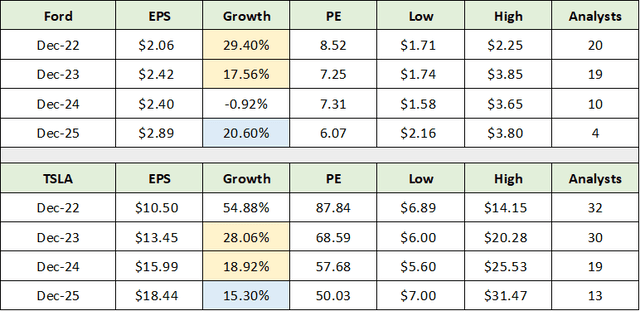
Source: Seeking Alpha. Created by Brian Kapp, stoxdox
It should be noted that Ford’s adjusted earnings per share excluding unusual items in 2021 was $1.52 per share. If the company hits consensus estimates through 2025, the four-year annualized earnings growth rate would be 17%. Given Tesla’s rapid manufacturing expansion in 2021 and 2022, comparing the three-year expected growth from 2022 through 2025 for Tesla and Ford is the most informative approach.
With the consensus 2022 earnings estimates as the baseline, Tesla is expected to grow earnings at an annualized rate of 21% through 2025. Over this same time period, Ford is expected to grow earnings at an annual rate of 12%. Please keep in mind that Ford is a mature company compared to Tesla. As a result, the 17% growth rate for Ford using 2021 as the baseline year is a very reasonable comparison to Tesla’s growth rate of 21% using 2022 as the baseline.
The highlighted cells encapsulate the relevant growth comparisons. Tesla’s growth expectations for 2023 and 2024 are remarkably similar to Ford’s for 2022 and 2023 (highlighted in yellow). Shockingly, if consensus growth estimates are achieved, Ford will be growing earnings more rapidly than Tesla in 2025 (highlighted in blue). The earnings growth profiles of Ford and Tesla are in fact quite similar. At minimum, this strongly suggests that the valuation of Ford and Tesla will converge through 2025
To be clear, I view Tesla’s valuation as an unrealistic expectation for an auto company. That said, Tesla’s valuation and the valuation applied to recent electric vehicle companies that have come public strongly suggest that the average valuation multiple across the market is in the realm of possibilities for Ford. It should be noted that Ford owns 11.4% of Rivian Automotive (NASDAQ:RIVN). Rivian recently came public and is currently valued at $60 billion, which is near Ford’s current $72 billion valuation. Rivian is an early-stage company and produces nominal sales at the moment.
Constructing an upside return spectrum for Ford is necessarily speculative given the incredible valuation applied to Tesla and startup electric vehicle companies. Applying the current S&P 500 forward earnings multiple of 20x would suggest Ford has upside potential to $40 based on the 2022 consensus earnings estimate. This translates into 125% upside potential. Given Ford’s 17% expected earnings growth rate through 2025, this is not an unreasonable expectation over a three-year time frame. If Ford begins to demonstrate success with its autonomous vehicle roadmap, the massive valuation upside potential would be additive to this upside return estimate.
Technicals
The technical backdrop for Ford strongly supports the upside estimate of $40 per share discussed above. This level was last reached in May of 1999. The following monthly price chart sets the technical stage. I have highlighted the key support levels with green horizontal lines and what looks to be the worst-case support level with a blue line. The primary resistance level is highlighted by the orange line.
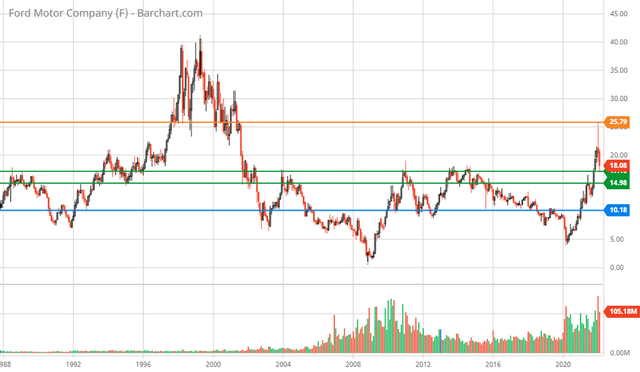
Ford max monthly chart. (Created by Brian Kapp using a chart from Barchart.com)
After testing the primary resistance level near $25 in January of 2022, Ford rapidly sold off after its Q4 2021 earnings report and is now testing the primary support zone between $14 and $17. It’s important to note that Ford breaking above $17 in recent months constitutes a breakout from the upper resistance level that has capped Ford’s shares since April of 2002. Due to this 20-year drought above $17, there should be little technical resistance above $17 if upside momentum resumes.
Technically speaking, given the 20-year sideways consolidation for Ford beneath $17, there should be extraordinary technical support between $14 and $17 (the green lines). This expectation for strong support is fully backed by Ford’s incredibly low valuation and its extraordinary growth prospects in autonomous vehicles. The blue line near $10 should be a worst-case scenario as things stand. Zooming into the five-year weekly chart provides a closer look.
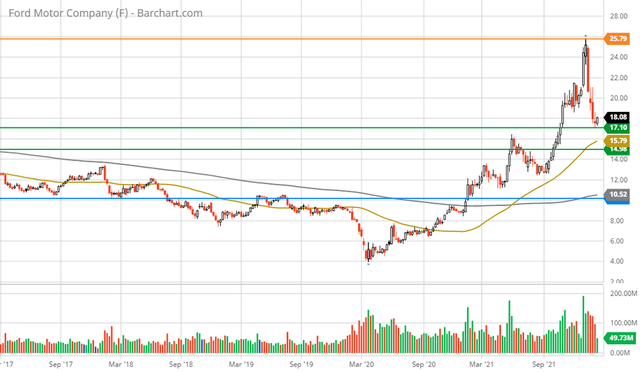
Ford 5-year weekly chart. (Created by Brian Kapp using a chart from Barchart.com)
Given the powerful move up from the COVID crash low of $4, it would not be surprising for Ford to test the $14 to $17 range as the stock remains technically overextended shorter term. This looks like an excellent accumulation zone. I view a retest of $10 to be unlikely given the valuation and growth outlook. Adding to the bullish technical backdrop is the 50-week moving average (the gold line near $15) crossing above the 200-week moving average (the grey line near $10) during mid 2021. This is referred to as a golden cross. A similar bullish moving average setup exists on the daily chart as can be seen below.
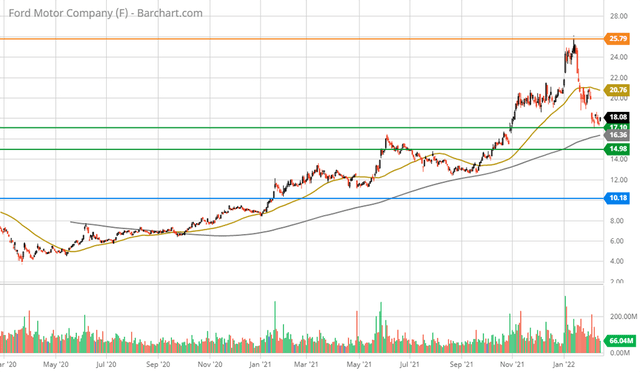
Ford 2-year daily chart. (Created by Brian Kapp using a chart from Barchart.com)
The gold line is the 50-day moving average and the grey line is the 200-day moving average. Clearly Ford is in a bull market with the 50-day moving average trending solidly above the 200-day moving average. The technical situation is characterized by a well-entrenched bull market that is undergoing a corrective phase. This is an ideal technical backdrop within which to accumulate shares.
Summary
Ford has just completed a decade of business stagnation alongside two decades of stock price stagnation. Throughout this adversity, Ford has implemented a methodical investment approach while developing a realistic roadmap for autonomous vehicles. These investments are now being rolled out to local markets opening the door to incredible growth opportunities.
These growth opportunities are beyond anything Ford has experienced in modern times. Tesla’s incredible valuation is a testament to the upside return potential that lies at the core of the Ford investment case. The fact that Ford is expected to grow earnings at a similar rate to that of Tesla through 2025 adds to the relative allure. When we look upon the automotive industry in 2025, Ford may indeed be more valuable than Tesla.
Editor’s Note: This article discusses one or more securities that do not trade on a major U.S. exchange. Please be aware of the risks associated with these stocks.


Be the first to comment